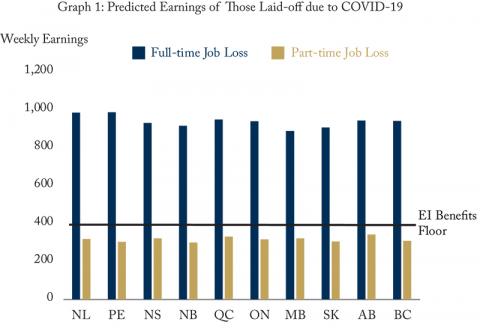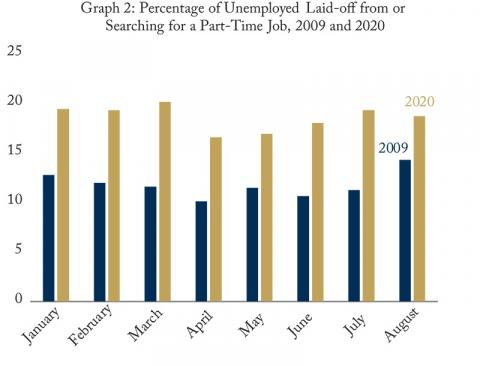From: Stéphanie Lluis
To: Canadians Concerned about the State of the Labour Market
Date: September 18, 2020
Re: Consequences of the high EI benefits floor (II)
My memo yesterday showed that Ottawa’s recently expanded Employment Insurance (EI) program with a benefit floor of $400 per week will mean replacement income of more than 200 percent for some part-time workers making minimum wage.
What are the potential short-term effects of this high benefit floor? An equation using Labour Force Survey data over the period of January 2018 to February 2020 lets us link hourly wages to employed workers individual and job characteristics, making it possible to predict the earnings of a sample of displaced workers who lost their jobs in March and April 2020.
Graph 1 shows that the average predicted weekly earnings of those who lost a full-time job are well above the EI benefit floor. Average earnings of the laid-off workers who lost a part-time job during the early stages of the COVID crisis (who worked an average of 17 weekly hours) are substantially below the benefits floor.
With the introduction of a benefits floor, one third of the workers who were displaced from a part-time job as a result of the pandemic and are still unemployed by September will have little monetary incentive to return to their old part-time work.
On average, the benefits floor generates a 19-33 percent increase in income from EI benefits over income from employment earnings for an average part-time worker who lost his/her job as a result of the pandemic. While many may be students or older workers approaching retirement, a significant proportion of the part-timers are women (from the LFS data and the sample of displaced workers in March and April who lost a part-time job, 64.8 per cent are women).
The short-term effects of fewer people seeking part-time jobs will have long-term consequences as well. For example, as women are disproportionately likely to be in part-time jobs, they are most likely to not have an incentive to return to such jobs. The wage penalty associated with career interruptions in terms of loss of human capital and accumulated experience can be substantial and for married women, the cost has been increasing in the last 50 years.
A guaranteed minimum benefit may influence the pandemic-induced job reallocation process away from low-paid jobs towards higher paid jobs and reduce poverty coming from job precarity. There is no question that contingent nonstandard employment with low pay and little protection (such as temporary contract work and gig employment) creates poor working conditions. Hospitality and personal services, two sectors mostly affected by the pandemic, are particularly prone to such contingent work. That may be the upside of the move away from part-time work.
Additionally, however, such a change will affect the productive mix of permanent full-time and part-time work desirable to firms and workers.
Part-time work has increased in the last 20 years. The trend persisted after the financial recession in the US and the UK and a similar evolution can be seen in Canada especially among women who are voluntary part-timers, at least until the start of the pandemic.
Of the 2.4 million people who usually worked part-time in February 2020, 77.5 percent did so for noneconomic reasons; more precisely, 73 percent of men and 80 percent of women are in voluntary part-time work. However, part-time work in Canada since the pandemic is showing a slower recovery relative to full-time employment. While this could be the result of seasonal trends, interest in part-time jobs is reflected in the increase in job search for part-time work in the past few months (Graph 2). Consistent with previous observations regarding increasing job search activity since February, the proportion of unemployed on temporary layoffs who lost a part-time job is higher in the last six months of the current crisis than over the equivalent months of the 2008-2009 financial crisis.
Among the unemployed who quit or were permanently laid off as well as among those transitioning back into the labour force for job searching, the percentages looking for a part-time job are also higher relative to the previous recession. The new benefit floor is going to reduce the number of part-time job seekers and potentially increase vacancy rates for this type of employment in the short-run.
In the medium and longer terms, an income support program that sets a generous guaranteed minimum benefit to EI recipients such as the newly introduced EI benefits floor may have an impact on the job reallocation our economies are currently experiencing. EI benefits that are more generous than an average part-time job at the minimum wage may help encourage job search for higher earnings full-time jobs by discouraging workers’ uptake of low earnings, short hours and more precarious jobs. It may also induce firms’ to rely more heavily on layoffs in a recessionary period.
However, a reduction in the take up and availability of short-hours part-time jobs will also compromise the productive mix of jobs and hours in the economy which can be detrimental to the recovery. It can reduce the effectiveness of other parts of the income maintenance program such as working while on claim aimed at maintaining individuals’ labour force attachment while unemployed. It can also impede the recovery of small businesses that more heavily rely on permanent part-time work. The reliance on permanent part-time work is twice as large for small and medium size establishments relative to larger ones. Finally, it will directly affect the joint labour supply decision of households optimizing their work and nonwork hours as well as women who increasingly seek jobs with flexible hours.
Stéphanie Lluis is associate professor of economics at the University of Waterloo.
To send a comment or leave feedback, email us at blog@cdhowe.org.
The views expressed here are those of the author. The C.D. Howe Institute does not take corporate positions on policy matters.
Notes: Predicted earnings from a linear regression of the log of annual usual earnings on education, age, occupations, a quartic in job tenure and a quartic time trend and monthly dummies over the sample of employed individuals from January 2019 until February 2020 using LFS PUMFs. Weights used in regression and kernel density estimations. COVID-19 laid-off workers are individuals reporting temporary and permanent layoffs in March 2020 with less than 4 weeks of unemployment duration.
Notes: Sample of unemployed on temporary layoff and job seekers transitioning from work and individuals entering unemployment and job search after a period spent out of the labour force.







